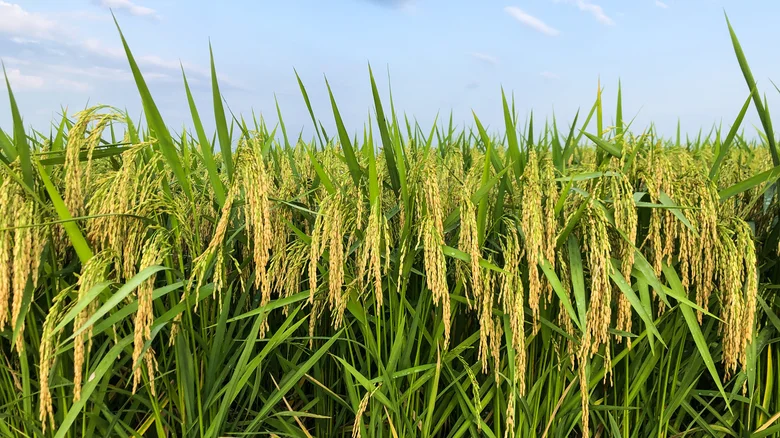Tags
The US State That Grows The Most Rice
BY ROBYN BLOCKER

The United States may not be one of the top 10 rice producing nations, but we still cultivate a substantial quantity of this staple grain. According to USA Rice, our rice industry generates more than $34 billion annually and supports the livelihoods of over 125,000 individuals across the country. Most U.S. rice production occurs in six states across four regions – California’s Sacramento Valley, Texas and southwest Louisiana on the Gulf Coast; Mississippi, Missouri, Louisiana, and some sections of Arkansas in the Mississippi Delta; and the Arkansas Grand Prairie. Among all of these rice states, Arkansas has been the top producer for more than half a century, now cultivating over 40% of the nearly 20 billion pounds produced in total (per Arkansas Farm Bureau).
While making basic stovetop steamed rice is simple, cultivating rice isn’t quite so easy. It’s semi-aquatic and needs to be planted in very wet, well-irrigated fields. Arkansas’ land, water supply, and climate more than deliver what the crop needs to thrive, and the numbers show it. In 2023, the Arkansas Farm Bureau reported 1,417,000 harvested rice acres with a yield of 7,550 pounds per acre. That’s a lot of rice, and the state exports more than 60% of it annually – over 9 billion pounds — to more than 25 countries. Still, if you enjoy making fried rice or can think of no better treat than a tres leches rice pudding, you may, at some point, have the state of Arkansas to thank for some of the yum in your life.
The types of rice Arkansas grows

Long-grain rice reigns supreme in Arkansas, constituting the majority of the state’s rice production. This rice variety, known for its ease of preparation and separate, fluffy grains, is a staple in many American households and aligns with the country’s overall production trend, which sees long-grain rice accounting for about ¾ of the total rice grown. Arkansas produces over half of it.
Though long-grain rice holds the spotlight in Arkansas, the state also plays a role in cultivating medium-grain rice, a variety known for its stickier, chewier texture when cooked (it’s the perfect rice for paella and risotto.) While medium-grain rice production is less extensive in Arkansas compared to long-grain, the state does cultivate a fair amount, particularly when drought conditions impact California, the top producer of this variety.
How Arkansas came to be the United States’ top producer of rice

Arkansas’ significance to the U.S. rice market began almost randomly, when Nebraskan farmer W.H. Fuller went on a hunting trip to Louisiana in 1896. Fuller, who had moved in a covered wagon to Lonoke County, Arkansas the year before, took one look at the fertile, teeming rice fields of Louisiana and realized that the absorbent clay and silt loam soils that nourished the crop were similar to that of his new home. Farmers working the prairie lands of Arkansas at that time had been seeking a crop besides cotton that could grow dependably and bring in consistent profits on a commercial scale. Rice, Fuller thought, could be just what they needed. He decided to try out the crop back home, investing $400 in the venture. And? It failed.
The reasons behind Fuller’s initial lack of success aren’t known, but what he did next is a well-documented lesson in perseverance. He packed his bags and went back to Louisiana, where he picked the brains of successful rice farmers for their secrets. Returning home in 1903, he bought rice seeds from local farmer Elias Moss, a formerly enslaved man who grew rice on a small scale for his own family’s needs. With seeds obtained from Moss and knowledge gleaned from Louisiana, Fuller succeeded in growing rice on a large scale on the Grand Prairie of Arkansas.
Fuller’s 1904 harvest yielded 5,225 bushels of rice culled from 70 acres. Six years later, Arkansas was already on its way to becoming the center for rice production that it is today, with research and milling operations also taking root.
https://www.chowhound.com/1675384/us-state-grows-most-rice-arkansas/Published Date: October 4, 2024






